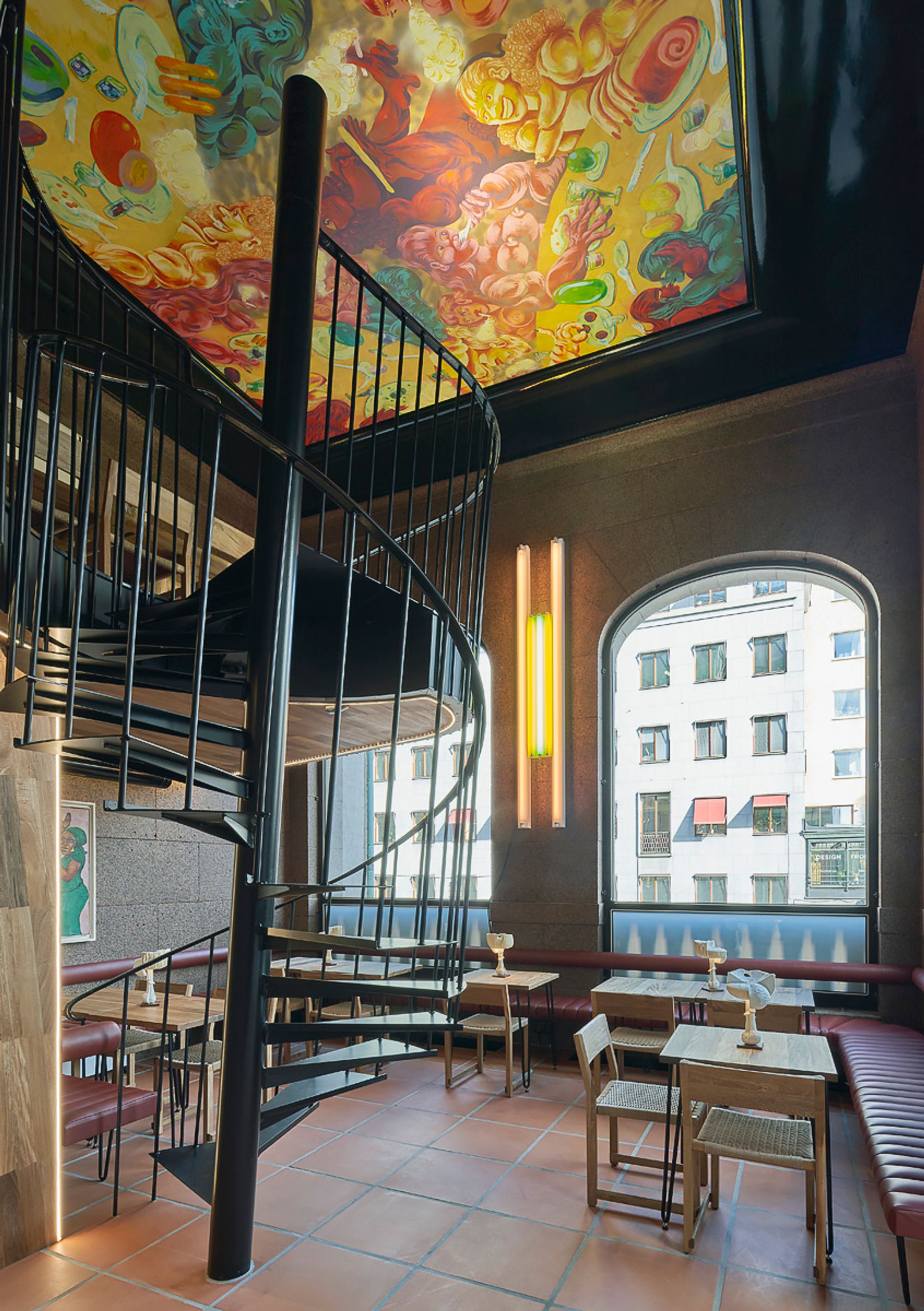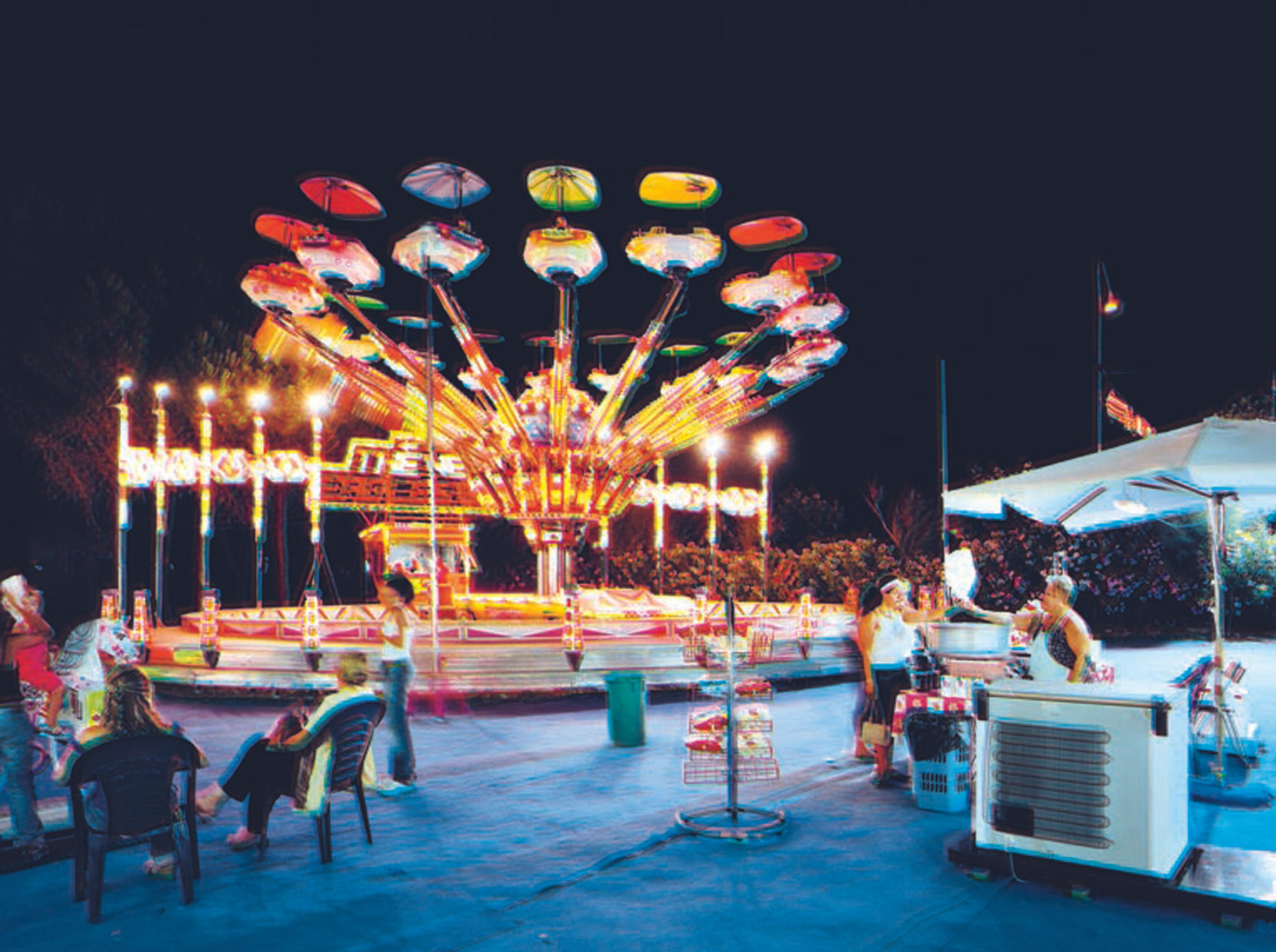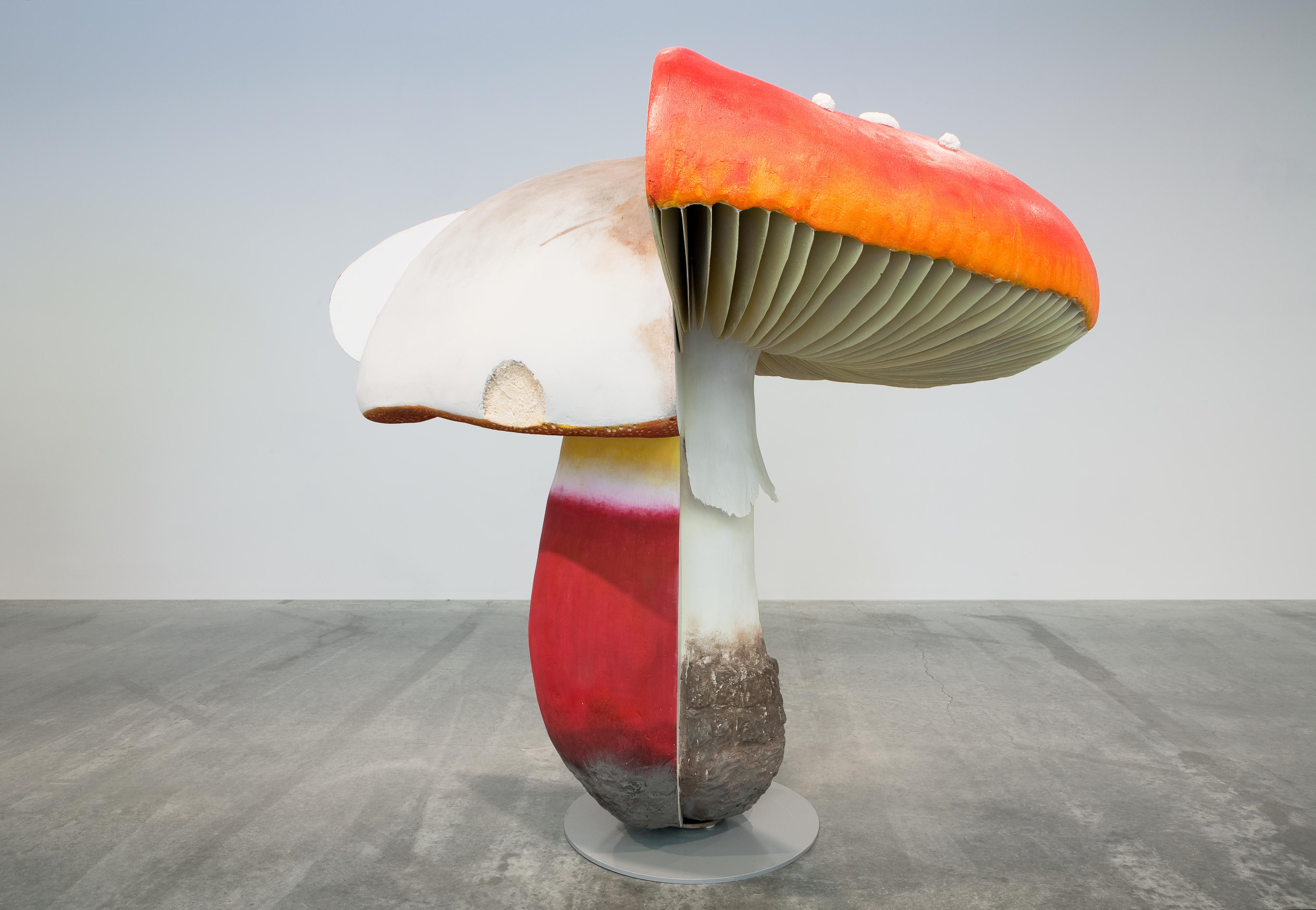
Brutalisten. Carsten Höller.

“Carsten Höller: Experience,” 2011. Exhibition view: New Museum, New York. Photo: Benoit Pailley. Courtesy New Museum
In Carsten Höller’s world, you can get strapped in a harness high in the air (Flying Machine, 1996), glide down five stories in a metal slide (e.g., Test Site, 2006, one of many slides he has done), or try a bit of hallucinogenic reindeer urine (Soma, 2010). His experiments are meant to leave a smile on your face, but not in a saccharine way — Höller’s grin is of the twisted, Lynchian variety. His work is disorienting and theatrical, winking social exercises meant to make us question ourselves and what we think we know. With artist Rosemarie Trockel, he made a concrete house divided in two with one-way mirror glass, one side for pigs, the other for people (House for Pigs and People, 1997). He has modified bumper cars, Gravitrons, and other childhood carnival favorites to turn at eerily slow speeds (e.g., Amusement Park, MASS MoCA, 2006), unsettling the mind where funfairs unsettle the body. Dividing his time between Biriwa, Ghana, and Stockholm, Sweden, the Brussels-raised German artist recently opened a restaurant in the Swedish capital called Brutalisten, a collaboration with chef Stefan Eriksson. Taking conceptual cues from the essentialist architectural style, Brutalisten serves three types of dish: “semi-brutalist” made with a couple of ingredients, “brutalist” featuring one ingredient and salt and water, and “orthodox-brutalist” made from only one ingredient. Even when working with something as universal and simple as food, Höller still finds new ways to confound and delight.
Emmanuel Olunkwa: You came to art from entomology?
Carsten Höller: Actually, I first trained as a phytopathologist. Phyto in Greek means “relating to the plant,” so I’m a plant doctor — like a vet, but for plants instead of animals. That’s my formal education, and from there I specialized in insects. But I didn’t know what to do as a boy. Should I be an artist or a scientist? It was never straightforward for me. My father told me, “You can always become an artist if you want, but not a scientist, because with science you have to go to university, complete a diploma thesis, and then you have to do your PhD.” I did all that, and then a year-long postdoc at Texas A&M University in College Station, followed by my Habilitation, the highest German qualification, which opens the way to professorship. But I already knew that afterwards I would stop practicing science — I could see the rest of my life in front of me, and I didn’t like it. I stopped when I was 32. I started studying very young and went to university at 17. I don’t know how that happened, I just went through the school system very quickly. And I had a similar experience as a scientist. So now I’m 60, but as an artist I’m only 28 years old. I’m still a young artist, you know? [Laughs.]
[Laughs.] Yes. How did you start practicing art?
It was simple. I just thought, “Okay. You have to be prepared.” I read anything about art I could get my hands on. And whenever I traveled somewhere, I would try to see as many shows as I could. But basically I taught myself. There was no one to tell me what to do.
Where were you living?
After Texas, I lived for a year in Munich. But I was already in my first big art show before I stopped being a scientist. In a copy of Flash Art I bought at the railway station, there was an ad for D&S (Different and Simulated), an exhibition with work by Jenny Holzer and quite a few other big names, which was supposed to happen the following year. I wrote a letter to the curators saying something like, “Hi, I’m a scientist. I’m at the university close by in Kiel. I have an idea for the exhibition. Can I come and present my idea?” And they said, “Yes.” So I went and presented my idea, and they said, “We’ll take it.”

Carsten Höller. Forte dei Marmi Giant Wheel, 2007. Chromogenic print on aluminum. 58 11/16 x 46 5/16 inches. 149 x 117.5 cm © Carsten Höller. Courtesy the artist and Gagosian.
What are the conceptual differences between working in science and art?
As a scientist, you have to know everything that has been done on a topic you want to research, and then you have to find something that has not been done yet, unless you want to repeat an experiment. It’s not about what you think as a scientist, it’s just about your data. You can discuss your data, which gives you a little bit of freedom of expression, but not very much. You have to stick to the rules. The worst thing for a scientist is to be a charlatan or a liar. It’s actually quite easy to cheat as a scientist, because your main goal is to get others interested in thinking you’re doing good work. But it’s very strict. As an artist it’s the opposite. You can basically start from nothing, without knowing anything. But even in art, there’s an idea about novelty. Not just expressing yourself, or something like that, but more like finding something nobody else has done, and finding a reason for that too.
Do you approach art-making as a science?
In a way. I mean, it’s me, right? It’s in me. I’ve been trained to formulate scientific texts in which you say nothing that’s not necessary.
What is your relationship to time? How do you experience it? I was thinking about food and space and I realized that time is the thing that binds them.
We all know that you cannot really think about time because it’s either something that doesn’t exist or abstractly has to do with the rotation of the Earth in relation to the sun. There’s no such thing as a singular time because we experience it differently across cultures and life-forms. I think it’s interesting that you could go to a place where there are no time-measuring devices, so you can’t tell what time it is, and as a result your circadian rhythm will change.
When tasked with conceptualizing a show, what do you think about? The context, the space, or the city?
Mainly the space. I want to understand it, because every space has a certain personality to it. As an artist, you’re usually given an exhibition space for a certain amount of time. You’re supposed to visit the site and make an exhibition. More and more, these spaces tend to be sculptures in themselves. Today’s architects have sculptural visions for how these spaces are going to hold things, but they don’t leave much room for the installations to speak for themselves. I was recently in a group show in Rome, at Zaha Hadid’s MAXXI museum. She’s designed some great buildings — I very much liked her Olympic swimming pool at Stratford in London — but this one is a catastrophe. It’s a big sculpture, but a bad building to show art in. You can’t just pretend it’s not there though, you have to live with it. It’s difficult. I have to consider my show independently of the building, which is sometimes very strong, sometimes very ugly, and sometimes beautiful. There’s a big window toward the city, and how do you cope with that? So, often you have to obey, in a way.

“Carsten Höller: Experience,” 2011. Exhibition view: New Museum, New York. Photo: Benoit Pailley. Courtesy New Museum
What are your aesthetic references? Your work reads very architecturally — though they’re functional sculptures, they feel like sets.
You’re right. They’re architectural in the sense that they can contain a human body. As with many of the things I do, I want them to be big enough that you can go in and expose yourself, like the die [in the installation Dice, 2014].
Why is the body so important to you?
I think about experience in terms of the body and value. We just opened a new restaurant in Stockholm called Brutalisten, and the dishes follow a brutalist manifesto where we cook using single ingredients and only add salt and water. I’m also working on a dream hotel with MIT, which I think is going to be interesting. Instead of being a purely visual artist who makes something that hangs on a wall, I like to approach making art as a bodily experience that’s more of an experiment.
What’s the Dream Hotel?
After we opened Brutalisten and had our first few nights of test dinners, as I like to call them, I went to Cambridge, Massachusetts. We met with scientists there who work with sleep and dreams. It’s interesting to refer to visual artists like the Surrealists, who used dreams in a novel way, and in architecture you have Antoni Gaudí, for instance, whose work is very dreamy. But in science, dreams have been taboo due to their extreme subjectivity. We want to make a hotel that contains seven rooms, with a science room on one side, which is a sleep laboratory, and an art room on the other side, which should basically evoke nightmares. In between are other rooms specifically designed to alter your dream experience and record it too. We want to find ways to let people deal with their dreams and ways to record brain activity while you dream, so as to translate them into something visual, an image with sound or something.
What are your plans for the restaurant?
[Laughs.] There is no explicit plan for the restaurant aside from the fact that it’s not a pop-up. It’s different from the Double Club project we did in London many years ago with Fondazione Prada. In 2008, I didn’t even know the term for what we were doing. I just wanted the space to exist for six months and thought it was a good idea. With Brutalisten, we have something that has a lot of potential. I’m hoping it can expand and we can open another location in the future or do pop-ups in other restaurants. It’s funny, because we have so many people who are interested in working with us now. It’s really fascinating to see. I’m only interested in doing it as long as it feels fresh and experimental.
How did you decide on the location? Did the architecture inspire the project?
Yes, it’s a place I walked past all the time. It used to be a music club with a little kitchen. When I went to check it out, I had ideas of expanding it and opening a restaurant. The main space was built in 1926, and it had a staircase going down to a lower level. Because it’s on a bridge, there’s one street above and another underneath, and the stairs connect the two levels. Now it’s a small restaurant, and you enter this space that’s 5 meters tall with a mezzanine that has walls made of huge raw granite blocks. We have a big ceiling painting by a young American artist, Ana Benaroya, and works by American minimalists. There’s a Dan Flavin that basically provides most of the light, and a Carl Andre piece, because I wanted to make a reference to minimal art to reflect our minimalist approach to food. Because we have artwork in the restaurant, people say, “Okay, it’s an artists’ restaurant,” but actually it’s not. It’s more emotive. I really like the idea of doing an experiment with people, like I do with other artworks.
How did you land on wanting the food to be the exploration of a single ingredient?
Well, I cook a lot myself, mainly because I’m so often dissatisfied with restaurants. I started the restaurant because I want this kind of food. I go there every day when I’m here in Stockholm. Sometimes I’m excited when I’m out shopping and I see, I don’t know, sea urchins. And by definition, you eat urchins raw. There are many other things that are nice just how they are. For example, if you cook something like a chicken, it already has everything — you don’t need any spices or butter. And we use the whole thing: the liver, heart, head, and skin. It’s a bit hard to explain, but it’s actually very good.
How have people responded to the name? Does the project hit home?
[Laughs.] People say, “What? It’s called what?” “Brutalisten,” I reply. And they say, “What’s that?” The first thing they think about is like taking a piece of meat, throwing it on the grill, and eating it off the bone. That’s not what it is. It’s just brutalist in terms of the ingredients and how we construct a dish. It’s about the essentials of the ingredients and the architecture. We’re not thinking about decoration or mixing unnecessary things. I think it makes a lot of sense.

Brutalisten. Carsten Höller.

Brutalisten. Carsten Höller.